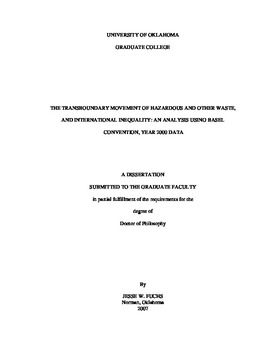| dc.contributor.advisor | Burns, Thomas J., | en_US |
| dc.contributor.author | Fuchs, Jesse W. | en_US |
| dc.date.accessioned | 2013-08-16T12:20:41Z | |
| dc.date.available | 2013-08-16T12:20:41Z | |
| dc.date.issued | 2007 | en_US |
| dc.identifier.uri | https://hdl.handle.net/11244/1198 | |
| dc.description.abstract | While there is a growing body of literature examining social causes of environmental outcomes, there has been a dearth of quantitative analysis examining the movement of hazardous waste across national boundaries from a global perspective. In an attempt to shed light on this vital but relatively neglected realm, this study examines data collected in conjunction with the Basel Convention on the international flows of hazardous waste among countries (n=99) in the year 2000. The study examines characteristics of destination countries (n=52) as well as countries of origin (n=96) along several dimensions. Predictor variables were drawn from a number of perspectives including sociology, economics, geography, demography, network analysis, and human ecology. Multivariate statistical analysis indicates that while the higher the level of biohazard, the more likely a shipment is to travel from a richer to a poorer nation, nations tend to ship waste to nations that are proximal to them geographically. The classic world-system framework positing a core, semi-periphery and periphery is not particularly useful in explaining the findings in this study. However, the study does support a modified world-system theoretical framework, in which richer countries within a region tend to export waste to somewhat poorer countries in that same region (many of which may be in the same tier of the world-system). An ancillary finding is that, while in theory, the total amount of waste exported by all countries should equal the amount imported by all countries, there were some discrepancies in the numbers. The aggregate amount of waste reported imported by destination countries was greater by almost 42% than the aggregate amount of waste reported shipped by originating countries. The work has a number of sociological, ecological and international policy-related implications. | en_US |
| dc.format.extent | xi, 318 leaves ; | en_US |
| dc.subject | Sociology, Public and Social Welfare. | en_US |
| dc.subject | Refuse disposal industry. | en_US |
| dc.subject | Hazardous waste management industry. | en_US |
| dc.subject | Hazardous wastes Transportation. | en_US |
| dc.subject | Sociology, Social Structure and Development. | en_US |
| dc.subject | Globalization. | en_US |
| dc.subject | Hazardous wastes Developing countries. | en_US |
| dc.subject | Political Science, International Law and Relations. | en_US |
| dc.subject | Geography. | en_US |
| dc.title | The transboundary movement of hazardous and other waste, and international inequality: An analysis using Basel Convention, year 2000 data. | en_US |
| dc.type | Thesis | en_US |
| dc.thesis.degree | Ph.D. | en_US |
| dc.thesis.degreeDiscipline | Department of Sociology | en_US |
| dc.note | Source: Dissertation Abstracts International, Volume: 68-04, Section: A, page: 1685. | en_US |
| dc.note | Adviser: Thomas J. Burns. | en_US |
| ou.identifier | (UMI)AAI3263356 | en_US |
| ou.group | College of Arts and Sciences::Department of Sociology | |
